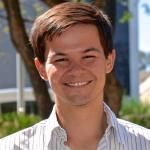Group B, Poster #178, Fault and Rupture Mechanics (FARM)
Exploring the Dynamic Interactions Between the Southern San Andreas Fault and Normal Faults under the Salton Sea
Poster Image:
.jpg?shYgOlVTr3_.Ctbyl4i0avtvJz1Dxtgq)
Poster Presentation
2022 SCEC Annual Meeting, Poster #178, SCEC Contribution #12565 VIEW PDF
p over and is characterized by continuous micro-seismicity and swarm-type activity. Although most of the seismicity in this area occurs along vertical NE-SW oriented strike-slip cross faults, there is clear evidence of slip along a network of SE dipping normal faults (Brothers et al., 2009, Brothers et al., 2011) under the Salton Sea. For that reason, the normal faults should also be considered as candidate initiation structures for future large earthquakes. Here, we provide updates on our ongoing work regarding the dynamic interactions between the SSAF and the local network of normal faults. To achieve this, we designed a series of dynamic rupture scenarios that help us investigate how SSAF events can transfer slip onto the normal faults, and the mechanisms by which normal fault earthquakes could trigger a major event on the SSAF. Our initial experiments are based on a model implementing the SSAF that is intersected by a normal fault near Bombay Beach. Preliminary results indicate that when earthquakes initiate on the SSAF, the nucleation location plays a catalytic role for slip triggering on the normal fault. More specifically, ruptures approaching from the north promote slip on the normal fault while this effect is reversed for ruptures initiating at the south of (Bombay Beach) the normal fault. Finally, to better capture the extensional features of the southern portion of the Salton Sea we are planning to update our models and run new simulations with a more extended network of normal faults.
SHOW MORE
SHOW MORE
















































